 Lamb satay There's a place in BF that serves lamb satay! Whee! That was my first reaction on reading the menu at Food de Sentosa, a Singaporean restaurant in Phase 3 that's been garnering quite a bit of attention lately. Business has been good so they are expanding the restaurant and adding five to six more tables next month.
Food de Sentosa is owned by Mr. Ronnie Teo, a Singaporean who's immigrated and married here. His son, David, turned out to be a co-teacher of mine at the College of Saint Benilde, but had to take a leave to help out at the restaurant due to the unexpected boom of demand there. He is now its full-time manager but you can also find him inside the kitchen helping his dad cook.
The elder Teo is a retiree who started the restaurant simply because he got bored after retirement. He had always loved cooking as a hobby and being the cook of the family, he brought in his family recipes as well as his own style of cooking and drew from Singapore's mixed Malay-Chinese heritage to build up Food de Sentosa's menu.
The eventual success of Food de Sentosa is one of life's quirks that just happens: With no business plan, no formal culinary training, no background in the food business, but armed only with a love of food and cooking, he launched his restaurant in November 2009. He never expected it would take off the way it has--they were even featured in the Philippine Daily Inquirer without their knowing a reviewer had visited--because he wasn't serious about it when he started, recalls David.
Today, they have regulars in and out of BF, like a fellow Singpaporean who travels all the way from Batangas just to eat there three to five times a week. Can you say Food de Sentosa addict?
One other reason for his success may be that Mr. Teo simply can't say no to any customer requests--he once cooked tempura for a customer. "Sometimes, he will cook something new on the spot and sometimes the dish would find its way to the menu the next day," David grins. He will also create new dishes with in-season ingredients like tom yao, kay lan, bok choy, and tang-o either from the local market or flown in from Singapore. (They also have kid-friendly dishes like Fried Fish Fillet with Chili Crab Sauce that's not spicy and custom-made prawn-flavored fried chicken).
 Nasi Goreng Cathy and I decided to try out the Lamb Satay -- hey, I never say no to lamb satay! -- the Black Pepper Beef, and the Nasi Goreng.
We loved the Lamb Satay, grilled to tender perfection and served with Mr. Teo's own traditional peanut sauce. Food de Sentosa's version of satay sauce is not as sweet as the Madurese version served in Pawon Ageng; I think it has more tamarind, and has a more herby aroma. Which do I like better? Give me both! Nobody ever died of a satay overdose, and one of these days when wifey is not watching I'm going to prove it! The sauce went very well with the unique aroma of lamb.
The Black Pepper Beef had a nice savory flavor, though not as hot as I would've expected from a Singaporean restaurant; unfortunately there were some tough bits.
I enjoyed the Nasi Goreng, Malay-style spiced fried rice with bits of meat, vegetables and egg, made savory with belachan, Malay dried shrimp. I rather wish the portion was a bit larger because we finished it before we could consume all the beef. The Nasi Goreng was really a meal in itself--a scrumptious one at that--so we could've gotten two and skipped the Black Pepper Beef.
I also wish I wasn't allergic to crab. A serving of chili crab went to the other table just as Cat and I finished eating, and the aroma simply grabbed me and almost made me forget I'd already eaten.
I've always said BF Homes needs more restaurants like these, and I'll say it again. Singaporean food is a great way for Pinoys to start sampling the wider galaxy of Asian cuisines, blending as it does the influences of Malaysian and Indian cuisine with the familiarity of Chinese, and Food de Sentosa is just the place for it.
One last detail: Why the color purple as the restaurant's theme color, we asked David. Because his dad didn't want the all-too familiar red, David laughs. Food de Sentosa's striking color was a great way to announce itself to the community a year-and-a-half ago, being the first restaurant here to use it in a big way. Today, his cooking and can-do attitude has endeared himself to his customers and has established his former hobby into a full-blown business.
Editors Note: We'd like to thank Ria Quintos-Ortega for reviewing Chic-Boy for Good Living BF.
SAVED BY THE FOOD
By Ria Quintos-Ortgega
I have heard many good things about Chic-boy from my friends and my party-legal children. I have been told me about their delicious Chicken Inasal and garlic rice with chicken oil poured over it with extra toasted garlic sprinkled on top. Doesn’t that just make your mouth water?!?! So I decided to bring my brood to the Chic-boy branch along President’s Avenue, BF Paranaque for dinner so I could see for myself what the fuss was about.
Let’s talk about what’s good about Chic-boy. First, parking was not a problem, considering it was a Sunday night, and the place was packed. There was more parking on the left side of the building too.
Second, the food was fantastic! Chic-boy is a play on the words Chicken and Baboy. We felt like the “boy” part of Chic-boy so we ordered the following items: My husband had the salmon sinigang, a double order of garlic rice, a double order of ginisang kangkong to share, and the Whole Cebu Lechon Liempo. My daughter ordered the SS-1 (Sizzling Special Meal Lechon Sisig served with rice and soup). My son and I both ordered a CB-6 (Chibog Busog Meal Cebu Lechon Liempo served with rice and soup).
The salmon sinigang was what I would like this dish to be. No scrimping on the salmon belly and soup sour enough to make your cheeks pucker. The garlic for the rice was toasted to perfection. The kangkong was very flavorful, well-seasoned and had the right crunch and color to it. The liempo is to die for with its delicious, well-marinated, juicy, succulent meat and crispy skin. It was lovely. The sisig was perfect - comparable to those served near the “riles” in Pampanga. There all sorts of textures at play with the softness and stickiness of the fat and crunch of the skin and the tenderness of whatever lean meat there is. Not to mention the added kick of the spicy sili! It was a rock concert in my mouth.
Third, Chic-boy is rice-all-you-can country! Yes, you read it right. This place serves unlimited rice. For those of you who are big fans of the stuff, the waiters go around carrying rice buckets, ready to plop a hot steaming heap of unadulterated carbohydrates onto your plate.
Lastly, you get great value for your money here. A very filling CB-6 meal costs P99. If you add a bottomless iced tea, it will come to about P124. Not bad at all!
Unfortunately, I do have some issues with Chic-boy, starting with the poor ventilation. The minute we walked through the door, the air was thick with the scent of barbecue smoke. It clung to my hair and my clothing. You must not shower before going here. Wait until after you get home or you’ll have to take another one if you do.
When we entered Chic-boy, we waited to be seated. The waiter approached us after a few seconds to tell us that we needed to place our order first, but we had to wait for a free table. He quickly added that there were people who were almost done anyway, so it shouldn’t be a problem.
Well, it was. After we had our orders efficiently taken by the person at the counter and was handed our order number, we had to look for a table. I approached one of the waiters and asked if there was a queue for seating. The reply was, “Wala po. First come, first serve.” I replied with, “That’s not a good idea.” People were circling the area for tables like vultures prowling for a meal. Some who came in after us got a table sooner just because they happened to stand next to some diners who finished earlier than expected. Not exactly first come, first served, is it? To be fair to the service staff, they rustled up a table once I grimaced at their response.
Once we were seated, we were served in trickles. The first to arrive were the drinks, the salmon sinigang, my husband’s double orders of rice and ginisang kangkong, and my daughter’s SS-1. My son had to follow up the rest of our orders 7 minutes into the meal. By the time the Whole Cebu Lechon Liempo and one of the CB-6 orders got to us, my husband was halfway through. They seemed to have forgotten my order, so I had to follow up on it. My CB-6 didn’t arrive until everyone was almost done. I was, then, pressured to wolf the delicious food down. I was so rushed that I wasn’t able to ask for the soup which is supposed to be available upon request.
The restroom? It was nicely appointed, but by the time I got to it, the liquid hand soap was so diluted, it may as well have been water. There were no paper towels to dry your hands with, and worse, there was no toilet paper. The toilet and urinal were not as clean as I would like them.
My verdict is this: If you’re in the mood for a no-frills, insanely affordable pig-out meal, with extra helpings of rice and well-prepared meat, Chic-boy is the place for you. I’d definitely go back to eat there again! Come on, guys! I’m rooting for you!
A house built on soup. That, in a nutshell, is Pat Pat's Kansi, a growing chain of Ilonggo restaurants whose core offering is a hearty beef soup called Kansi. Cat and I got to visit the BF Homes branch and met owner Enri Rodriguez, who told us Pat Pat's story.
 Kansi - Laman
Pat Pat, it turns out, is an Iloilo lass who as a child kept asking for a particular beef soup from Bacolod. It got to the point that her
mom, rather than taking the ferry to Bacolod just to buy the stuff, reverse-engineered the recipe and added her own touches to make the Kansi that would later take Makati by storm. What's Kansi? It's the Ilonggo version of Bulalo, beef marrow soup, but cooked with a sour fruit called batuan plus the secret herbs and spices added by Pat Pat's mom. It's so flavorful, says Enri, that there's no need to add soy sauce or patis to the soup as most Tagalog diners usually do with their bulalo. Years later, the family put up a small restaurant along Kamagong in Makati. It's now devilishly difficult to find parking along Kamagong at lunchtime, with so many of Makati's office workers heading for Pat Pat's Kansi.
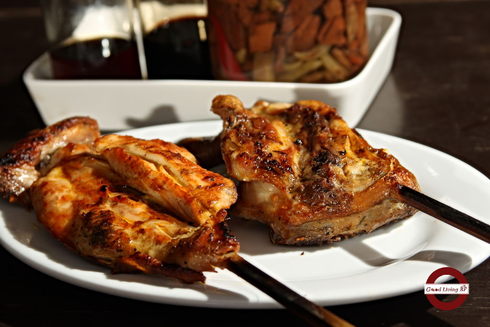 Inasal - Pecho
Cat and I sampled the signature Kansi, the indispensable Iloilo/Bacolod favorite Chicken Inasal, Pork Barbecue and the Sizzling
Sisig. First stop, the Kansi: we opted for the Kansi Laman (meat), an all-meat version, rather than the Bulalo (bone marrow) - I've been taking in too much cholesterol lately! On my first spoonful of soup I could already tell this beef had been lovingly boiled into submission over a slow fire, the flavor was so rich. Because we'd been shooting the other dishes the soup had gone cold, but Enri gave us fresh broth to bring our bowl of kansi back to steaming the way it should be enjoyed. The beef was very tender, and Cat, who usually takes her boiled beef with some kind of sauce, found she needed to add nothing at all as Enri smilingly advertised. Me, I'm the guy who always likes fire on the palate so I used the provided calamansi, fresh chilies and soy sauce to make a hot dip. Either way it went down great (had to try Cat's version too!).
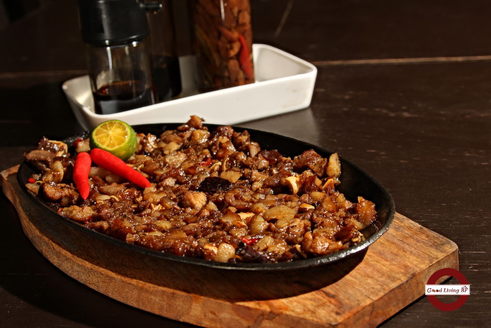 Sizzling sisig
The Inasal tasted just like those we had in Bacolod, smoky and tangy, while the Pork Barbecue was garlicky-sweet like the barbecue I grew up with. Both went down very well, though I found a bit more gristle than I liked on one stick of the barbecue. The Sizzling Sisig was a wow - really spicy the way I liked it, spiked with chopped chilies and fried to a crisp on a hotplate.
You'd expect a place that serves sisig like this to be a beer drinker's haven as well, but here we found another unique aspect of Pat Pat's Kansi: in line with its original concept as a down-home, family-friendly place, alcohol simply isn't on the menu. And because the owners want to keep the focus squarely on their strongest suits, the menu is restricted to only ten dishes, which if the four items we sampled are any indication they do really well indeed.
 Pork BBQ
Speaking of menus, the place has been discovered by a new market--our Korean visitors. A Korean traveler stopped by last year and found the food to be very much in line with the Korean taste. So determined and enthusiastic was he to recommend Pat Pat's Kansi to his compatriots that he insisted to draw up a testimonial right there and then, which the Rodriguezes printed on a banner, and they now also have a menu with entries in Korean script.
Pat Pat's Kansi BF Homes branch is located at the lower level of Greenworld Plaza along President's Avenue. The place has ample parking, a requirement which Enri says the franchisors wisely made a prime requirement. The restaurant is Enri's first venture into the food business, and it's one he made based on his good relationships with the franchisors and his belief in the product. As he narrates, he took his wife Lea to sample the Kansi, and she was sold on the idea immediately. I have to say, after the first try we're sold on Pat Pat's Kansi too.
We've just discovered a new Japanese street food place along President's Avenue. It's called Kushiten, which in my fractured understanding of Japanese boils down to 'heaven for everything on a stick.' If you've a hankering for yakitori, this is the place to find it -- about a dozen varieties of it, and all of them made with an authentic, light Japanese touch.
Kushiten's secret weapon is owner/chef Kath Kaneko and her culinary blue blood - her father is a Japanese chef and their family used to own the Keiyu Japanese restaurant in Phase 3. Kushiten's menu is a reflection of what Kath herself loves most in Japan, its variety of skewered street foods. The menu was inspired by a street stall that she always visits when she goes to Tokyo. Banking on the Filipino's love for grilled and fried dishes, Kath designed Kushiten to showcase the streets of Tokyo's best in a casual, relaxing atmosphere that welcomes Japanese expats and Filipino barkadas and families alike.
 Left Photo (l-r): Tebasaki, Tsukune, Buta Aspara. Right Photo: Momo and Negima When I order yakitori, I usually know what to expect: tender bits of sweet-salty chicken on sticks. That's it. In Kushiten, though, there's a lot more to it than that. Cathy and I sampled Momo (chicken dark meat), Tebasaki (chicken wings), Tsukune (balls of ground chicken), Negima (chicken with leeks), and Buta Aspara (thin strips of pork rolled around fresh asparagus tips). I have to say Kath has a very light hand with her marinades, so you can savor every nuance of the ingredients' flavor without them being overwhelmed in sweetness or the saltiness of soy sauce. I can see why the Japanese expats eat here.
The yakitoris went very well with a bowl of Chahan, Japanese fried rice.
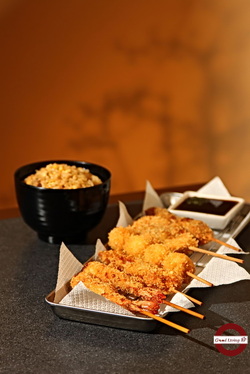 (From bottom) Kushiages - Ebi, Gyu, Uzura Tamago, Sakana, Ika After the yakitoris we tried a variety of kushiages, namely the Gyu (beef), Ika (squid), Sakana (fish), Ebi (shrimp,) and a surprise, the Uzura Tamago (quail eggs). By default these are served with a sweet kushiage sauce, but Kath also urged us to try them with tartare sauce and her own Kushiten sauce. One of the draws here, she explained, is that you can order kushiage with the sauce of your choice, including chili mayo and wasabi mayo if you want a hot kick. Cat and I found that each kushiage tends to go best with a different sauce -- the tartar was great with the fish and squid; I found the Kushiten sauce was fantastic with the quail eggsl and the sweet kushiage sauce went very well with the beef. If you're going to bring kids here, the kushiages are guaranteed to be a hit with them! Trust me - I'm very in
touch with my inner kid.
We also had a plate of fried Gyoza, an all-meat dumpling, again with Kath's own gyoza sauce. Cathy's a gyoza connoisseur, almost never failing to order it when we eat Japanese; so when she says she likes a gyoza, I know we're going there again. As for me, I liked that the gyoza sauce here has more ginger and is less sweet than usual; I find that it brings out the taste of the gyoza filling better. We then had our vegetables in the form of an Okonomiyaki, a sort of savory pancake made with shredded cabbage and topped with a light, sweet sauce, Japanese mayo, seaweed flakes and dried bonito flakes. This dish is surprisingly hefty, and can make a filling snack on its own or be a good side dish to go with the light yakitoris and kushiages.
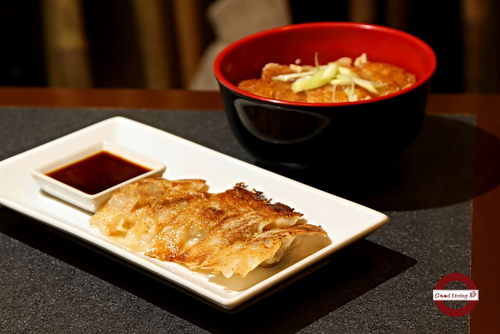 Gyoza and Katsudon As there's inevitably one big eater in every group, Kushiten is coming out with a line of donburis, or rice topping bowls, by next week. We got a sneak preview of the Katsudon, a breaded pork cutlet on rice. Kushiten's katsudon comes in a rather large serving, and is drenched in a special sauce that adds juiciness to the fried pork and makes the rice really savory. I guess this is the Japanese version of comfort food, so comforting I didn't want to get up from my chair anymore after I finished it! This friendly place with its delicious, authentic and surprisingly budget-friendly Japanese food is going to be among my top recommendations from now on.
When the first returning OFWs from the Middle East brought back shawarma, they knew they had a hit on their hands. Such a hit, in fact, that we Pinoys very soon had our own versions. One of the best-done versions I have to say is from Food Channel, a shawarma and snack chain that originated in a kiosk by an escalator at the ground floor of Virra Mall in Greenhills in the early 90s, spreading all over the metropolis and finally coming to BF Homes, their first branch at the south. Cat and I got to know Food Channel BF Homes franchisers JP and Joyce when we went to try them out.
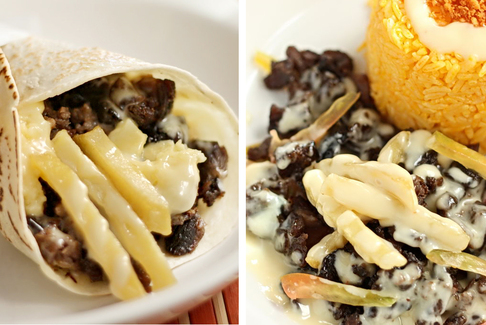 Beef Shawarma & Beef Shawarma with Rice At first I didn't recall that I'd eaten at Food Channel's Greenhills stall before, but the signage and the menu were somehow familiar. Then JP told us its origins, and I had it -- I'd been noshing on Food Channel's shawarma since the 1990s. They now offer a wider variety of very affordable, below Php100 food choices. Aside from their signature Beef Shawarma with Cheese, we also tried the Shawarma Rice, the Korean Beef Rice, and the Barbecue Rice.
Food Channel's All Beef Shawarma is a real Pinoy shawarma, made to satisfy the bottomless hunger of students and late-night snackers. It's literally bursting with crunchy beef, made heftier with the addition of cheese and a side of french fries (yes, shawarma and fries!). For the size, amount and quality of beef you're getting, this shawarma is well worth its price of PhP 95. It's not filled with as much onion and tomato like Lebanese shawarma, but the Lebanese-style garlic sauce - thick, smooth, and creamy -- is still there, and the spicy sauce is very good. For those with a really big appetite -- note that the Beef Shawarma is already a meal in itself -- the Shawarma Rice is the same shawarma served with a cup of Java rice.
 Korean Beef Rice 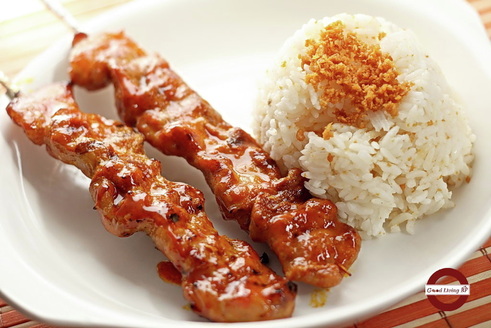 Barbecue Rice The Korean Beef Rice is another meal for those days when you're desperately in need of something good to fill you up, fast. Flash-cooked strips of tender beef, marinated in sweet Korean-style marinade and served on a bed of caramelized onion, this is a treat I can definitely go for after a long night of gaming or writing when the body inevitably demands some munchies.
Same goes for the Barbecue, which to our surprise was cut really thick. I've gotten used to barbecue from the neighborhood stall, which as typical for barbecue is cut thin for fast cooking; Food Channel's is thick yet very tender, the sweet-savory flavor of the marinade soaking through and through. You can literally sink your teeth into this one!
 Blueberry Pancakes Other goodies you may like are their Tapsilog, Sisig, Korean Beef, Gourmet Tuna Wrap, and Fried Siomai to list a few. This branch even serves breakfast comfort foods all day - the bestsellers are their Tuna Shitake Mushroom Melt Omelette, Blueberry Pancakes, and Chocolate Chip Pancakes.
Food Channel BF Homes has targeted the early morning risers to the late sleepers and everyone in between by opening its doors from 8 a.m. to 3 a.m. Adding enjoyment to your dining experience is an entertainment set and free WiFi. They’ve just opened their catering services in time for the Christmas season and will soon offer free deliveries as well.
Boss Chief Inasal is a newly opened inasal, or barbecue, house along El Grande that can boast the true Bacolod taste. This cozy little nook, sitting no more than a dozen or so, is clean, cozy, conducive to hang around in -- and serves some mean inasal and La Paz batchoy.
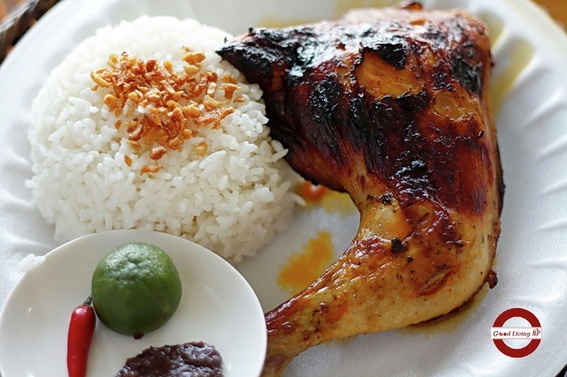 Chicken Inasal Chicken Inasal is a deceptively simple dish, being just chicken marinated in a pickle of vinegar, soy sauce, garlic, ginger, pepper and turmeric, but there are just some cooks who do it so right you'll remember them and come back for more. Boss Chief has one of those cooks. We both got a leg quarter each, and they were done just right, cooked through but still thoroughly juicy and flavorful inside and out. They also added an innovation to the presentation of their inasal by serving it with a dip of bagoong (which they make themselves), calamansi, and chili in addition to the usual garlic-and-chili vinegar dip. As I'm allergic to bagoong, it was Cat who tried her inasal this way and she finds it much to her liking. "It's surprisingly well-suited for the dish, and I'm wondering if there is anyone else who's serving it this way," Cat says. At just 90 bucks for a combo meal of a leg quarter or breast with garlic-topped rice and a soft drink, Boss Chief's price compares very well with other inasal houses.
 La Paz Batchoy On top of our barbecue, Cat and I also shared a bowl of La Paz Batchoy, another of my favorites from the Visayas. Boss Chief's batchoy comes in a surprisingly hefty bowl, easily enough to constitute a hearty eater's lunch all by itself. The savory broth is apparently made using pork cheeks, the same flavorful cut used for making sisig, thus its rich flavor. In the broth were generous portions of fresh noodles, meat, slices of liver, and a sinfully delicious topping of chicharon, green onion and fried garlic bits. Now this is soup! Mrs. Melissa "Ging" Matubis, Boss Chief's Inasal's chief, is also testing the market by offering Manapla puto as an add-on for the batchoy, and she let us sample some. Very hearty! Being an Ilongga herself, Cat says this is still her favorite kind of puto. I liked it that the noodles were cooked just right, and tasted fresh; the last time I had a craving for batchoy and bought from another store the noodles were horribly soggy and had a bit of a funny taste already. Boss Chief Inasal is walking distance from my place, so I think you know where I'm getting my next bowl of batchoy.
As I like telling Cat, I know only four words of Ilonggo: Inasal, Batchoy, and Namit gid (delicious!). At Boss Chief, that vocabulary is all I need.
|


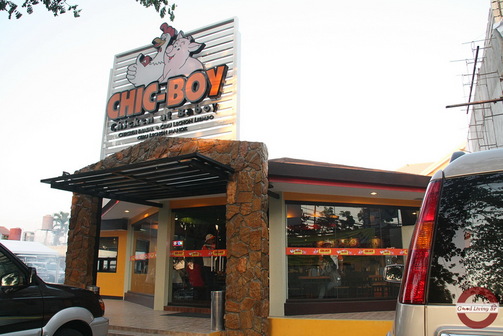














 RSS Feed
RSS Feed